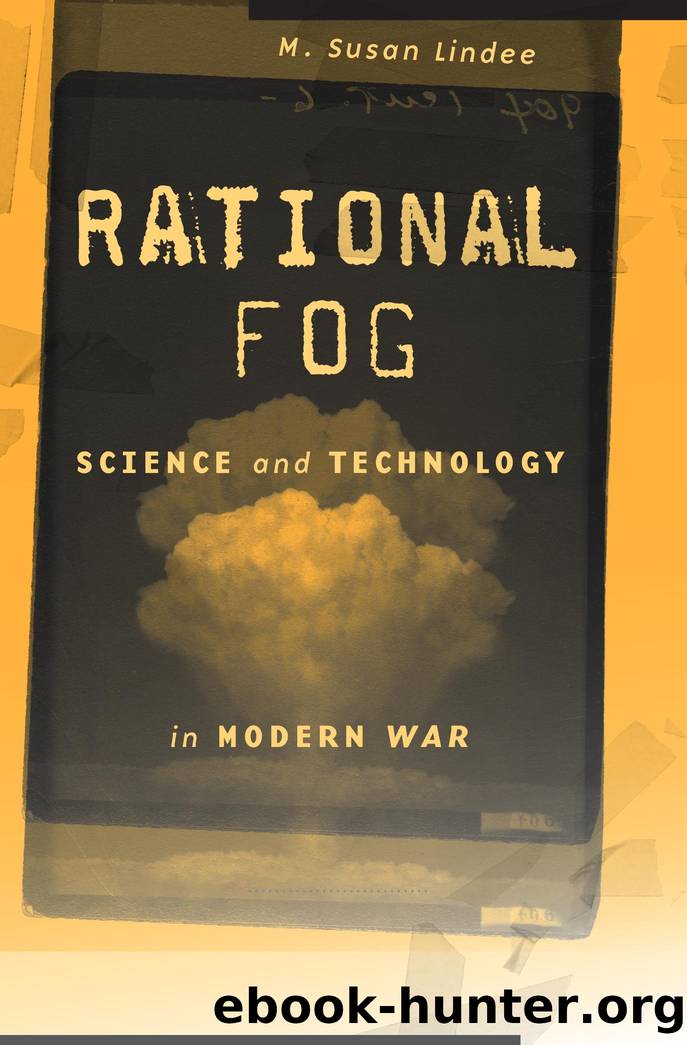Rational Fog: Science and Technology in Modern War by M. Susan Lindee

Author:M. Susan Lindee [Lindee, M. Susan]
Language: eng
Format: epub
Tags: potential seeds
ISBN: 9780674250246
Google: BCfTzQEACAAJ
Publisher: Harvard University Press
Published: 2020-10-15T10:12:11+00:00
FIGURE 10. Pilot in Physiological Crisis: The face transformed by motion. Eugene M. Landis, The Effects of Acceleration and Their Amelioration, in E. C. Andrus et al., Advances in Military Medicine, Made by American Investigators, vol. 1 (Boston: Little, Brown, 1948), page 251, figure 33.
In these wide-ranging studies, a visual, x-ray, quantitative, biochemical, and psychosocial record of the stresses of high altitude and high-speed air travel was created as a resource for air power planning. Human subjects (soldiers, undergraduates, medical volunteers, divers, and climbers) modeled the experience of long, cold, uncomfortable, and dangerous flights. Their bodies provided guidance as engineers reconfigured cockpits and clothing for pilots and crews.
These studies at many different institutions were forms of what we might call normal science. This is the term for scientific studies undertaken within an established paradigm for understanding phenomena. The idea of ânormal scienceâ was first articulated by Thomas Kuhn in his influential 1962 book, The Structure of Scientific Revolutions.22 Important to the concept is the idea that scientific research commonly draws on an established, broad consensus that certain kinds of questions are important and relevant. In the case of the nascent field of aviation medicine, creating controlled human injury under laboratory conditions was clearly a matter of broad consensus.
Both the airplanes and the people placed inside them were seen as malleable. Some people might be less vulnerable to decompression sickness. Some psychological states might be controlled with drugs. And the airplane itself could be modified to reduce the damage of midrange accidents. The ultimate goal in aviation medicine was to keep pilots and crews alive and functional for as long as possible under as many conditions as possible. This would permit them to continue their bombing missions, that is, keep them healthy so that they could fly high enough and long enough to injure and kill persons on the ground in targeted areas. While the emphasis in the formal texts of aviation medicine was on the survival and safety of crews, that survival and safety by definition facilitated death and injury to others on the ground. Aviation medicine was simultaneously knowledge of healing and of injuring.
Those already grievously injured also became the focus of field research during the war, for example in Henry Beecherâs studies on the Italian front (Figure 11). Beecher (1904â1976), a Harvard anesthesiologist, was one of the most influential figures in twentieth-century medicine. He wrote a widely discussed paper in the 1950s that defined the placebo effect. His papers on unethical research in the 1960s essentially launched the modern bioethics movement. He also later helped to redefine death as brain death, a policy that facilitated organ transplantation. Whatever one makes of Beecher as a personâand he was a complicated person as both Laura Stark and Susan Lederer are helping us to understandâhe certainly had an impact on the practices of biomedicine.23
Download
This site does not store any files on its server. We only index and link to content provided by other sites. Please contact the content providers to delete copyright contents if any and email us, we'll remove relevant links or contents immediately.
| Automotive | Engineering |
| Transportation |
Whiskies Galore by Ian Buxton(41884)
Introduction to Aircraft Design (Cambridge Aerospace Series) by John P. Fielding(33064)
Small Unmanned Fixed-wing Aircraft Design by Andrew J. Keane Andras Sobester James P. Scanlan & András Sóbester & James P. Scanlan(32744)
Craft Beer for the Homebrewer by Michael Agnew(18145)
Turbulence by E. J. Noyes(7942)
The Complete Stick Figure Physics Tutorials by Allen Sarah(7310)
Kaplan MCAT General Chemistry Review by Kaplan(6868)
The Thirst by Nesbo Jo(6832)
Bad Blood by John Carreyrou(6557)
Modelling of Convective Heat and Mass Transfer in Rotating Flows by Igor V. Shevchuk(6391)
Learning SQL by Alan Beaulieu(6213)
Weapons of Math Destruction by Cathy O'Neil(6148)
Man-made Catastrophes and Risk Information Concealment by Dmitry Chernov & Didier Sornette(5924)
Digital Minimalism by Cal Newport;(5667)
Life 3.0: Being Human in the Age of Artificial Intelligence by Tegmark Max(5476)
iGen by Jean M. Twenge(5367)
Secrets of Antigravity Propulsion: Tesla, UFOs, and Classified Aerospace Technology by Ph.D. Paul A. Laviolette(5310)
Design of Trajectory Optimization Approach for Space Maneuver Vehicle Skip Entry Problems by Runqi Chai & Al Savvaris & Antonios Tsourdos & Senchun Chai(5011)
Pale Blue Dot by Carl Sagan(4913)
